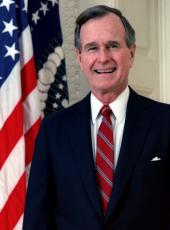Let me just first greet the members of the fire-service community, Members of Congress who are here, officials from FEMA, Fire Marshal Bernard Johnson, Fire Chief Rayfield Alfred, my own firefighters -- call them my own -- Engine Company 13 and Tower 10 -- welcome to the White House. We've got a few fires to put out around here, and that's why I've been late. [Laughter] Thank you very much.
More than 2,100,000 fires broke out in the U.S. this year, claiming 6,000 lives. Fires strike at the most vulnerable among us, especially children and the elderly. And it also strikes the most valiant among us; many casualties are, indeed, the firefighters who lose their lives in a last-ditch struggle to save someone else's life.
Then, after the cost in lives, we've got to count the enormous property losses in excess of $8 billion. Now, these dollars cannot adequately represent the tragedy of so many beloved homes, churches, and businesses literally going up in smoke.
There is an army of dedicated Americans who stand ready to fight these fires, any-time, anyplace: the more than 1 million firefighters. The organizations involved in fire prevention efforts are too numerous to mention. But all are true heroes, and their heroic role is on display here today for National Fire Prevention Week.
At the Federal level, the U.S. Fire Administration, part of FEMA, is the national leader in firefighting and emergency response. These men and women from the Fire Administration are dedicated to the development of effective programs to help fire departments, State and local governments, private business and organizations, and educators promote fire safety and awareness in communities across the country. At the State level, many dedicated agencies labor to provide training courses for firefighters and emergency medical technicians, arson investigation services, and research. And of course, in virtually every community across this great country are the men and women who make up the front lines in the battle, the firefighters, both career and volunteers, who continue a long and distinguished tradition of firefighting that goes back all the way to the first volunteer fire company founded by Benjamin Franklin in 1736.
Congress also has a role to play through the Congressional Fire Services Caucus, whose cochairmen are Senator McCain and Congressman Curt Weldon. The caucus boasts 370 Congressmen and Senators -- 370 -- making it the largest on Capitol Hill. Most of all, Congress recently updated our safety laws in the Hotel-Motel Fire Safety Act, authored by Congressman Sherry Boehlert.
All of these groups, from volunteers to Members of Congress, can tell you that the best way to fight fire is not with fire but with prevention. The National Fire Protection Association does a great job in this endeavor, working with young people such as Shanta Jones, the 1990 NFPA national fire safety poster contest child winner. In this and in so many other ways, they are getting the word out on fire prevention.
As you know, Tuesday marked the anniversary of a key event in American history, the great Chicago fire, a sweeping conflagration that destroyed most of that great city back in 1871. Years later, outrage over devastating citywide fires led to a national effort to prevent fires.
To focus this national campaign, President Wilson proclaimed October 9, 1920, National Fire Prevention Day. In 1922 President Harding made it Fire Prevention Week, saying that fire prevention should be practiced "by every man, woman, and child not only during the week designated in this pronouncement but throughout every hour of every day of the year."
That's true today. Every hour of every day, we can help save a life by preventing a fire. And we can keep these brave men and women with us today from having to risk their lives to save ours.
So, I am again very pleased to be with you all and to sign the proclamation declaring this week as National Fire Prevention Week. Thank you all for coming down.
Note: The President spoke at 2:45 p.m. in Room 450 of the Old Executive Office Building. In his remarks, he referred to Bernard C. Johnson and Rayfield Alfred, fire marshal and fire chief of the District of Columbia Fire Department. The proclamation is listed in Appendix E at the end of this volume.
George Bush, Remarks on Signing the Fire Prevention Week Proclamation Online by Gerhard Peters and John T. Woolley, The American Presidency Project https://www.presidency.ucsb.edu/node/265049


